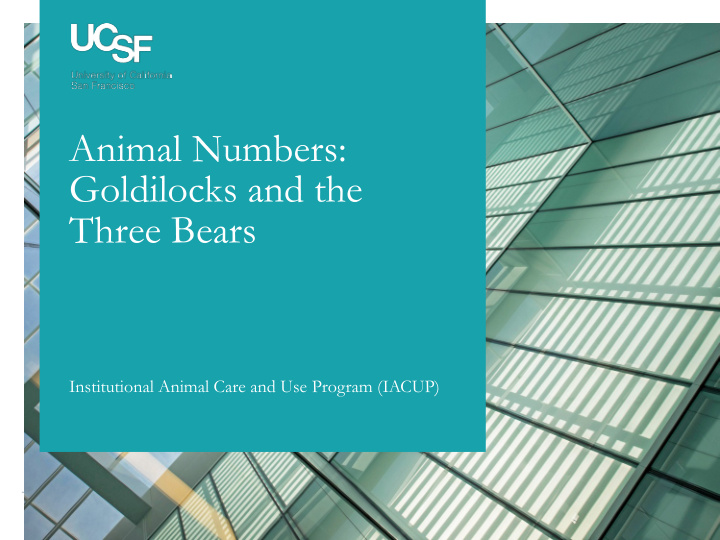



Animal Numbers: Goldilocks and the Three Bears Institutional Animal Care and Use Program (IACUP)
Why should I care? US Gov’t Principles: “ Principle III : The animals selected for a procedure should be of an appropriate species and quality and the minimum number required to obtain valid results ..” PHS Policy: “D.1.: Applications and proposals…that involve the care and use of animals shall contain the following: a.) Identification of the species and the approximate number of animals to be used; b.) rationale for involving animals, and for the appropriateness of the species and numbers of animals to be used …” USDA AWR: “§2.31(e): A proposal…must contain the following: (1) Identification of the species and approximate number of animals to be used; (2) A rationale for involving animals, and for the appropriateness of the species and numbers of animals to be used…”
Why should I care?
How do I get started?
How do I get started?
Load ’em Up! Training Animals Primary Outcome Variables Measured Methods of Comparison P-Values Expected Variations Pilot Studies within Groups Justifications Breeding Replicates
I got rejected. Now what?
K.I.S.S Philosophy “We need # of experimental animals. No power analysis is available, because it is the first experiment of its kind. We are one of the pioneers of this technique” “We need # of experimental animals. We used this number in past experiments and found significant results, so we will continue to use this number.” “We need # of experimental animals.”
I got rejected. Again. Now what? How do we achieve a balance of descriptive text with power analyses, study designs, and other rationale with an easily- digestible tabulation of our animal numbers? How do we ensure that our animal numbers are arithmetically accurate and our study designs are not flawed? Find the balance between overpowering a study and using too many animals and underpowering a study and using too few animals (which may inevitably result in using more animals than originally required)
Animal Numbers Spreadsheet
Magnum Opus!
Magnum Opus! A B C D E F G H Total animals required Lines Experimental Outcomes Experiment to complete one Experiment n (group size) studied groups Time points measured replicates experiment Circadian Rhythm Light/Dark cycle manipulation 12 34 1 2 1 1 816 Running wheel activity monitor 12 39 1 2 1 1 936 Behavior tests 12 14 1 2 3 2 2016 EEG/EMG/Optogenetics manipulation 10 28 2 3 1 1 1680 Longevity-RNAseq Longevity-RNAseq 4 10 2 5 1 1 400 Per3 Circadium Manipulation Depression Screening 12 5 2 1 1 2 240 Text # # # # # # =PRODUCT(B#:G#)
Magnum Opus! H I J K L M Total animals required to complete one Model success experiment rate (%) Total animals required Total acquired Total bred Arithmetic Error? 816 100% 816 0 816 No 936 100% 936 936 No 2016 80% 2520 0 2520 No 1680 90% 1867 0 1867 No 400 100% 400 80 320 No 240 100% 240 0 240 No =IF(SUM(K#:L#)=VALUE(J#) =ROUNDUP( H#/(I#), 0) ,"No","YES! Check math!") =PRODUCT(B#:G#) # # # Total Cat D 6779 80 6699 No
Does it work?
Where do we go from here? Integrated sample size calculator - Plug in: statistical test, effect size, standard deviations, alpha, and power - Return out: sample size Breeding calculator - Plug in: # of experimental animals, specific breeding efficiencies, and % desired sex/genotype/etc. - Return out: # of breeders RIO integration - “Plug’n’Chug”
Questions?
Recommend
More recommend